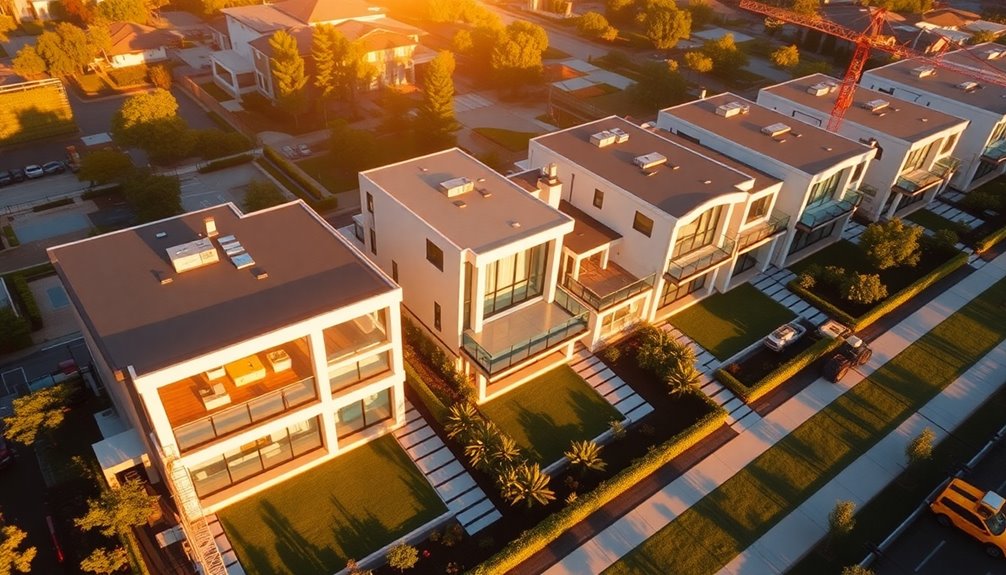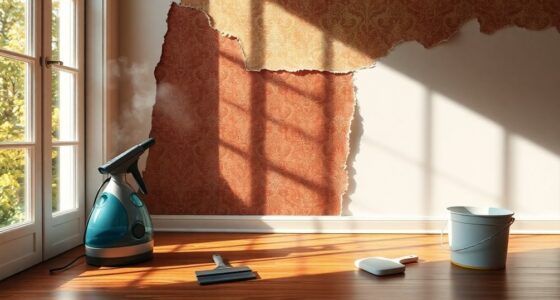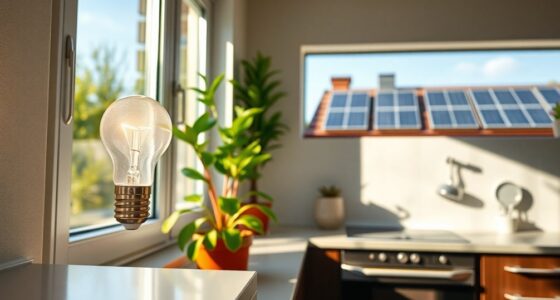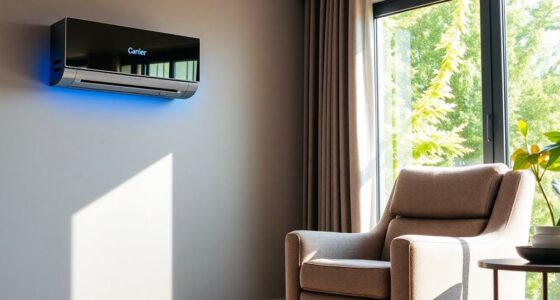Contemporary homes are pricey due to several factors. Custom designs require high-quality materials, like steel and glass, driving up costs considerably. Open floor plans need extra structural support, and advanced HVAC systems add further expenses. Additionally, location impacts prices, as desirable areas often see higher land acquisition costs. The ongoing demand for skilled labor and rising material prices due to supply chain issues contribute to the steep expenses. If you're curious about how these elements interact and shape today's housing market, you'll discover even more intriguing insights ahead.
Key Takeaways
- Custom features like windows and unique roof designs significantly increase material and construction costs for contemporary homes.
- Open floor plans require additional structural support and advanced HVAC systems, raising both labor and material expenses.
- High-quality materials such as steel, glass, and concrete enhance aesthetics but come with a steep price tag.
- The integration of smart home technologies adds considerable costs due to advanced materials and specialized labor.
- Economic factors, including labor shortages and fluctuating material prices, contribute to the overall expense of contemporary home construction.
Design Elements and Their Costs
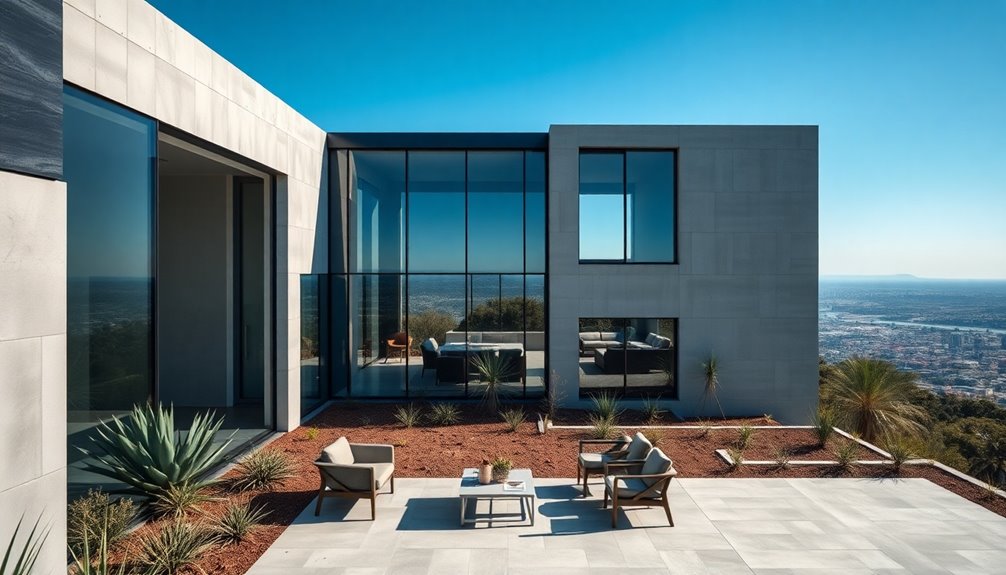
When planning your contemporary home, understanding the costs of design elements is essential. Architectural features like custom windows can set you back between $10,000 and $30,000, while unique roof designs may cost $3.50 to $30 per square foot. Open floor plans often require more materials, driving up expenses. Incorporating smart home technologies adds considerably to your budget, but innovative materials, like veneer flooring, can help you save. High-quality materials such as steel, glass, and concrete enhance aesthetics but come at a premium. Luxurious finishes—think hardwood flooring and granite countertops—elevate your home's value, and the overall cost can vary significantly depending on home size and location.
The Impact of Floor Plans
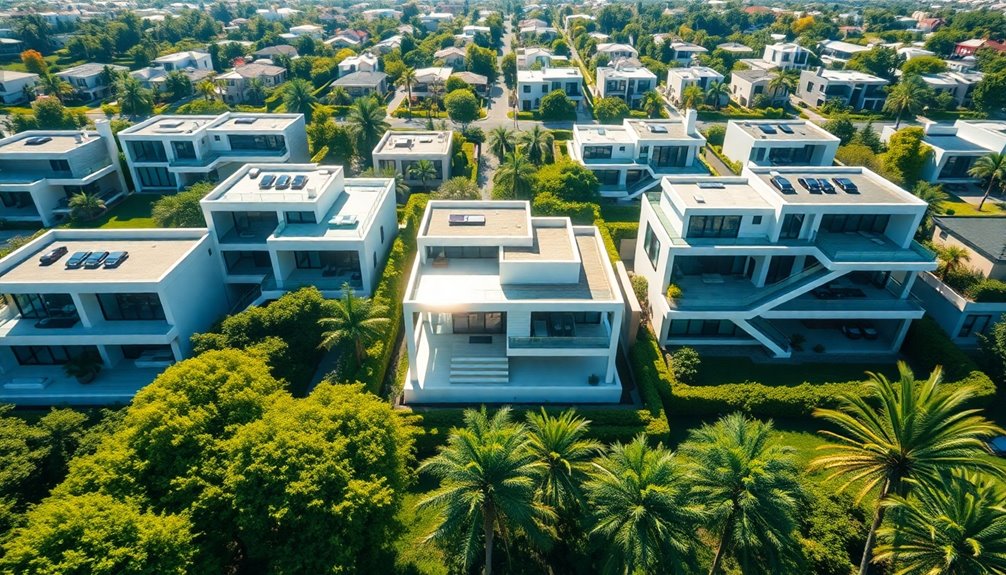
The impact of floor plans on contemporary home design is significant, as they shape not only the aesthetic appeal but also the structural integrity and functionality of the space.
Fewer walls mean you'll need additional structural beams, raising labor costs and necessitating precise material selection. The sleek lines of contemporary designs demand meticulous construction, leaving no room for imperfections, which also increases material expenses. Moreover, many contemporary houses incorporate eco-friendly elements that can further add complexity to the overall design.
Open floor plans create larger living spaces but require advanced HVAC systems and more electrical outlets, adding to costs. Custom layouts may enhance flexibility and appeal but typically involve higher design fees and specialized labor.
Ultimately, the complexity and customization of floor plans play an essential role in driving up contemporary home prices.
Land Acquisition and Grading
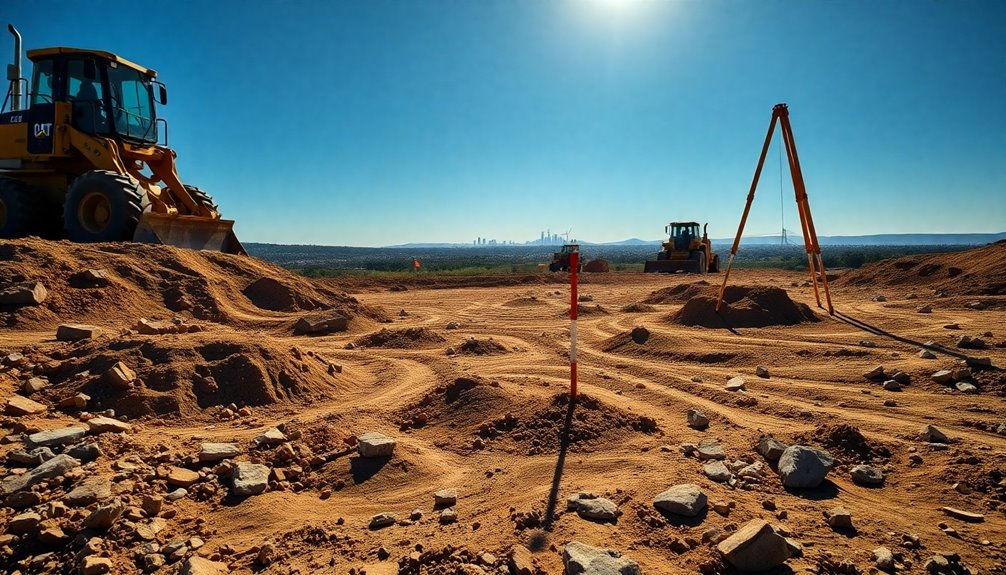
Acquiring land for your contemporary home is a critical step that can greatly impact your overall budget. The purchase price varies widely based on location, size, and zoning regulations. If you're eyeing a desirable area, be prepared for high demand driving prices up. Compliance with local zoning laws can also add to your costs.
Once you secure the land, grading and site preparation come into play. Excavation, topography adjustments, and soil testing can make your budget swell.
You'll also need to factor in utility installation and erosion control measures. Don't forget about permits and skilled labor for clearing and grading.
All of these elements combined can greatly influence the total cost of your contemporary home.
Customization and Complexity Factors

Building a contemporary home involves multiple customization and complexity factors that can greatly affect your budget. High-quality materials like premium wood and bespoke finishes can considerably increase costs. If you opt for custom floor plans or intricate architectural features, you'll need to budget for skilled labor and potential engineering fees. Upgrades in kitchens and bathrooms, along with energy-efficient systems, can add up quickly. Additionally, integrating smart home technology and outdoor features like patios will further inflate your expenses. Remember that hiring experienced designers or architects comes with a premium, and permitting costs can also pile on. All these elements contribute to the overall complexity, making your dream home more expensive than you might initially expect. Furthermore, many clients find that upgrades generally range from 10-20% of the total home cost.
Location and Pricing Differences
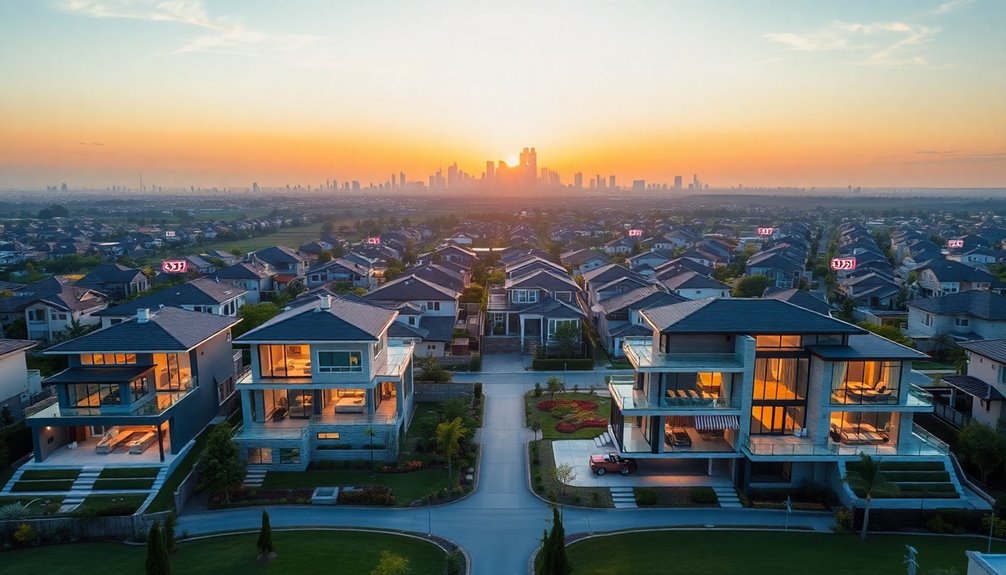
When considering where to build your contemporary home, it's crucial to recognize how location can greatly influence pricing.
Urban areas typically have higher prices due to demand, proximity to amenities, and job opportunities. Conversely, rural locations offer lower land costs but fewer services.
If you're near major job centers, expect higher prices for the convenience of shorter commutes. Quality education is another factor; homes in top school districts often come with a premium, making them appealing to families.
Additionally, properties with scenic views or access to recreational activities tend to be more expensive.
Ultimately, understanding these location-based factors can help you make informed decisions and maximize your investment.
Size and Construction Expenses
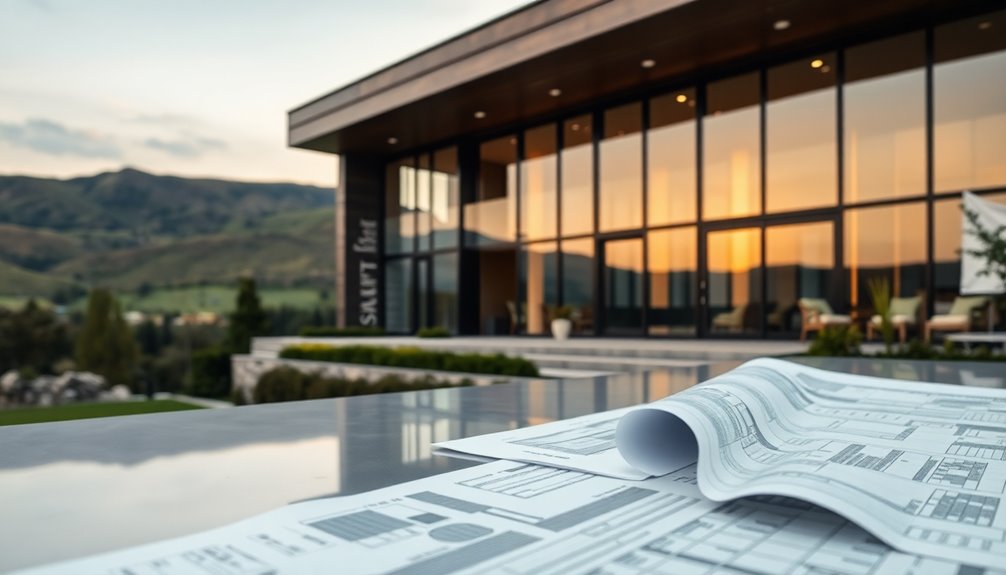
As you plunge into the world of contemporary home construction, understanding how size impacts construction expenses is essential.
Larger homes require more land, and rising demand in urban areas drives those prices up. Zoning regulations can limit available land, further increasing costs. Plus, homes near amenities like schools or shopping centers come with a premium.
Construction methods also play a role. Advanced techniques, such as energy-efficient designs or smart home technology, add to the expenses. Skilled labor is often necessary, which increases labor costs.
Regulatory compliance, including building codes and permitting fees, can further inflate your budget. Remember, every square foot you add not only raises material costs but also affects overall expenses considerably. Additionally, incorporating features like heat pump systems can significantly enhance energy efficiency, ultimately affecting long-term operational costs.
Quality of Materials and Finishes
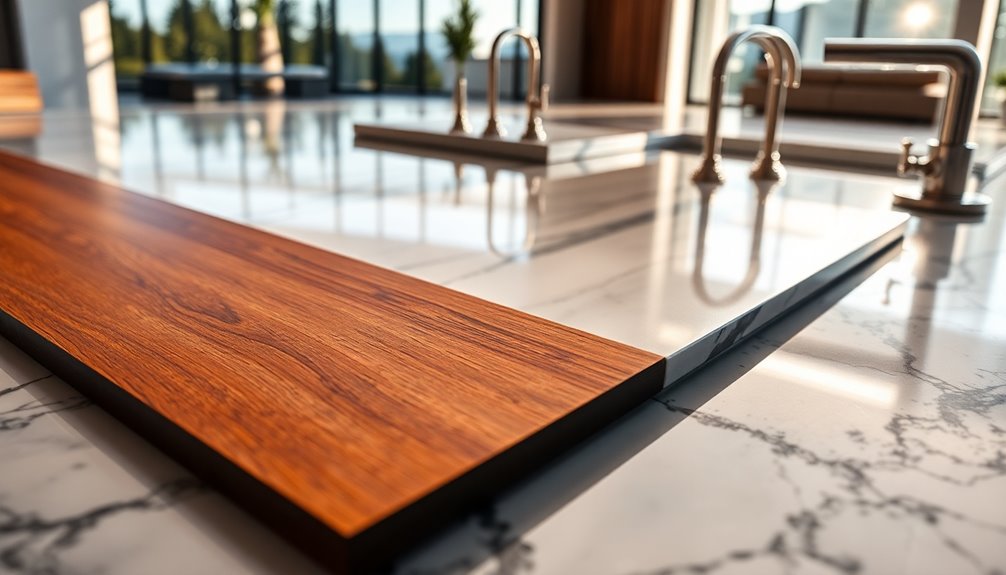
Choosing the right materials and finishes for your contemporary home can greatly influence your overall costs. High-end options like luxury flooring, premium cabinets, and advanced insulation can considerably bump up your budget.
For instance, if you opt for exotic hardwoods or custom cabinetry made from solid wood, you're looking at a considerable price increase. Finishing touches like designer plumbing fixtures and advanced lighting systems also add to expenses.
Plus, skilled labor for custom installations and quality control guarantees that these high-end materials are installed correctly, driving up labor costs.
While investing in sustainable and eco-friendly materials may be pricier, they offer both quality and environmental benefits that can enhance your home's value in the long run. Additionally, selecting energy-efficient appliances can further contribute to long-term savings and sustainability in your contemporary home.
Economic Influences on Prices
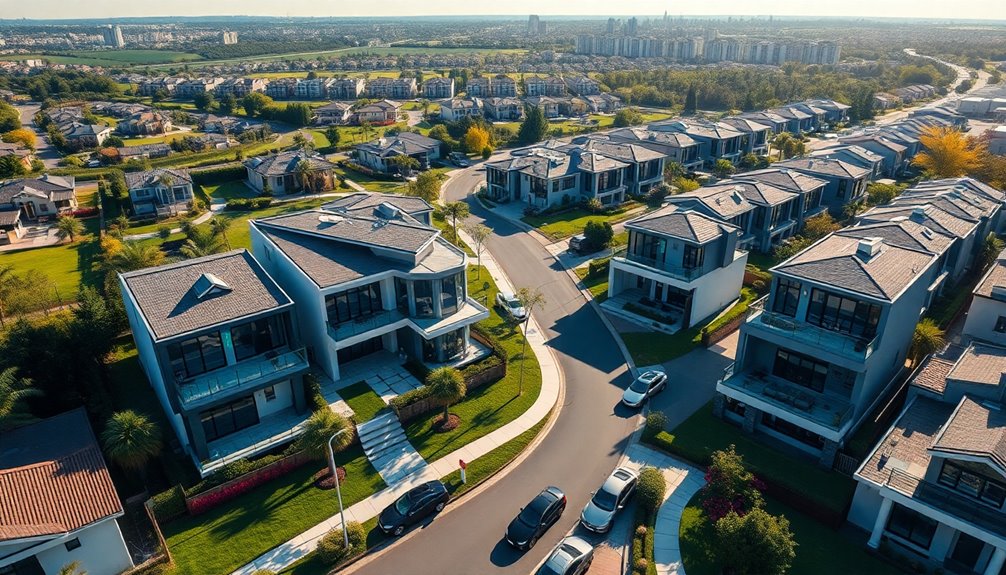
Economic factors play an essential role in determining the prices associated with building a contemporary home. Labor costs have surged due to increased demand for skilled workers, coupled with a shortage in critical fields like plumbing and electrical work. This drives wages up, impacting your overall expenses.
Material costs also fluctuate, influenced by global supply chain disruptions and rising raw material prices. Additionally, inflation and interest rates can affect your construction financing, making it pricier to borrow for your dream home.
Finally, regulatory compliance adds another layer of costs, as stricter building codes and environmental regulations require more resources. All these economic influences contribute to the escalating prices you face when building a contemporary home.
Government Policies and Market Trends
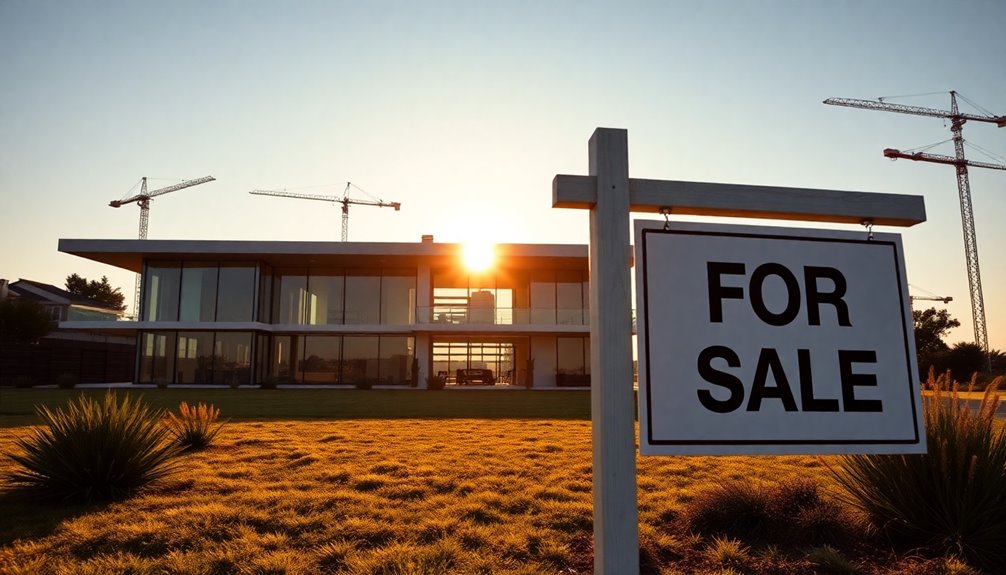
Government policies and market trends substantially shape the landscape of contemporary home costs. Tax incentives like the first-time homebuyer's credit can temporarily boost demand, leading to higher prices. For instance, millions benefited from the 2009 tax credit, demonstrating how government actions can spur buyer interest.
Meanwhile, strict zoning laws limit housing supply, further driving up costs. Programs like Tenant-Based Rental Assistance offer affordable options, but local governments' land use decisions often dictate their effectiveness. Additionally, factors such as environmental influences can impact housing development and availability. Initiatives to repurpose federal land for housing could help, yet lasting solutions to affordability remain elusive. Notably, federal funding through programs like the Tenant-Based Rental Assistance significantly supports over 5 million individuals, illustrating the critical role of such initiatives in addressing housing challenges.
You see, while policies can create short-term gains, they often fall short of addressing long-term housing challenges, leaving many to navigate an increasingly expensive market.
Frequently Asked Questions
How Do Contemporary Home Designs Affect Resale Value?
Contemporary home designs greatly boost resale value because they combine modern aesthetics with functional features. The seamless integration of open floor plans and energy-efficient technologies attracts buyers looking for both style and sustainability. Additionally, the difference between traditional and contemporary design lies in their approach to space and light, with contemporary homes often emphasizing minimalist elements and larger windows that invite natural illumination. This innovative use of space not only enhances the visual appeal but also creates a more inviting atmosphere, further increasing the home’s desirability on the market.
You'll find that energy-efficient systems, sustainable materials, and smart technology attract buyers seeking eco-friendly living.
Open floor plans and ample natural light enhance appeal, making your home feel spacious and inviting.
Plus, incorporating health and wellness features can set your property apart, appealing to a growing market focused on well-being and lifestyle benefits.
What Financing Options Are Available for Building Contemporary Homes?
When you're looking to build a contemporary home, you've got several financing options.
Traditional bank loans, like fixed-rate or adjustable-rate mortgages, provide reliable funding.
Construction loans are tailored for building projects.
Alternatively, consider private money lenders or government-backed loans for more flexibility.
If you're into innovative solutions, crowdfunding or real estate investment trusts can also be viable.
Each option has its perks, so choose what best fits your financial situation.
Are Energy-Efficient Features Worth the Investment?
When you consider energy-efficient features, think about the benefits they bring.
Sure, the initial costs might seem high, but you'll save on energy bills over time.
Plus, government incentives can help offset those upfront expenses.
You'll also enjoy improved indoor air quality and greater comfort in your home.
Ultimately, investing in energy efficiency isn't just about cost; it's about creating a sustainable, healthier living environment that benefits both you and the planet.
How Does Landscaping Contribute to Overall Home Costs?
Landscaping greatly boosts your home costs by enhancing both initial investment and ongoing maintenance.
You might spend thousands on design, plants, and hardscaping, plus labor and permits. Over time, you'll also incur costs for upkeep and seasonal decorations.
However, well-executed landscaping increases curb appeal and property value, offering potential returns at resale.
Ultimately, investing in landscaping not only beautifies your space but can also pay off in the long run.
What Are Common Maintenance Costs for Contemporary Homes?
Imagine owning a sleek, modern home with a stunning glass facade. You quickly realize that maintenance costs can add up.
Unique materials like polished concrete and specialty roofing demand higher upkeep. Structural challenges, such as extra beams for support, require precise labor.
Plus, high-tech features like advanced HVAC systems need regular servicing. Don't forget about landscaping and pool maintenance, which can also be time-consuming and costly.
Conclusion
In today's housing market, the price tag on contemporary homes can feel like a heavy anchor, but understanding the factors behind these costs can lighten the load. From design choices to location and materials, each element adds to the overall expense. As you navigate this complex landscape, remember that knowledge is your compass. By staying informed, you can make smarter decisions that fit your budget without sacrificing the dream of your perfect home.
